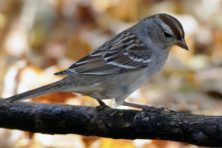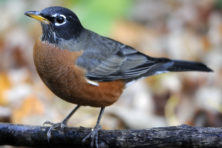Door to Nature: Fall Migration Begins
- Share
- Tweet
- Pin
- Share

Maybe you’ve noticed there is very little bird song now that the nesting season is nearing the end. American goldfinches are beginning to breed as the thistle seeds are producing the material used in their nests, but most other birds are finished raising their young.
Some species, like the shorebirds that breed in the far northern part of the continent, were on their way south by mid-July. We wonder how the terrible Canadian wildfires are affecting birds that nest in that country, or have to migrate through it.
Spring migration is a rush to find territory and mates with lots of gorgeous breeding plumage. Autumn migration is much slower. There is no need to secure breeding grounds and mates. There are more birds moving through with lots of youngsters following the adults south in a more leisurely pattern with more muted plumage.
I remember seeing a half dozen Tennessee warblers around the broad, satellite-dish birdbath in late August one year. They seemed to enjoy communal bathing. Perhaps the splashing sound and motion attracted others to join them.
County records indicate that the common nighthawk, a wonderful bird to watch flying, swooping and turning to catch insects, can be seen as early as mid-August. The last date reported here in fall was Sept. 15, 2021.
They like to fly close to sunset and often appear just over the treetops as they catch their food. Their wings, distinctive in shape, have a broad white band across the outer wing feathers, known as “primaries.” The bird is about nine inches in length, but has a two-foot-wide wingspread.
They are not as common as they were 30 to 40 years ago and can breed throughout the U.S.
Common nighthawks spend the winter in much of South America. The first Wisconsin report of migrating nighthawks came in on Aug. 10 this year from a birder in Grafton.
Another bird I used to enjoy seeing in mid-to-late summer is the chimney swift. They, too, have distinctive wings, as if they were flying boomerangs. They are named for their roosting and nesting habits in brick chimney. Bird expert, Tom Erdman of Oconto, said that when he studied the work of Carl Richter, also of Oconto, he found records of chimney swifts nesting in barns as well as chimneys.
There is an effort currently underway to find older, large buildings that still have the tall, brick chimneys for roosting swifts on their journey south. Karen Etter Hale is in charge of this project. You can go to wiswifts.org to report any location where you see masses of chimney swifts flying into their evening roosts.
Ruby-throated hummingbirds are another species we see regularly at our feeders all summer. The adult males are easy to identify compared to the white-throated females. Soon the youngsters should be at your feeders, as well.
By early September the adult males are the first to head south. Then the adult females will leave. The last to go are the youngsters, perhaps by mid-to-late September. One wonders how the immatures, just hatched a month or two ago, know where to fly on their autumn trip south.
Swallows and purple martins are another group which we look for in late summer. The purple martin population has decreased drastically over the last 40 years. There used to be martin houses in many shoreline villages in Door and Kewaunee Counties. Now, only a few are occupied.
My bluebird trail houses tree swallows, too. Once the young swallows leave the nest, we do not see any of them again. I think they tend to go to the inland lakes or shorelines to do their insect-catching. Other swallows, like the northern rough-winged swallow and bank swallow, are gone by early September. Barn swallows tend to remain longer, sometimes into October.
The last group of migraters is the warblers. There are many which do nest in our area but quite a few other species breed further north and fly through Door County on the way south. Palm and Tennessee warblers have nested in far northern Wisconsin, but the rest – orange-crowned, bay-breasted, blackpoll and Wilson’s – are more common further north in Canada.
We did have a confirmed nest of Cape May warblers near the northern tip of the Door Peninsula. That was because an invasion of spruce budworms developed in spring about 28 years ago and one of the volunteer birders for the first Atlas of Breeding Birds of Wisconsin found them. That insect is a favorite of the Cape May.



